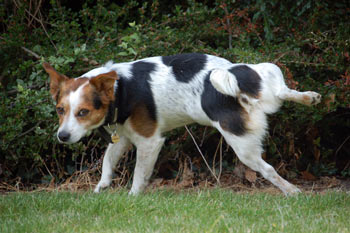Bladder Problems In Dogs

Bladder problems are a common health concern in dogs. The medical term for bladder trouble is cystitis, Greek for inflammation of the bladder. By any name, it causes discomfort and misery. People with cystitis describe a cramping, burning sensation when they attempt to void urine. Dogs with bladder trouble may display any or all of the following symptoms:
- Straining to urinate
- Urinating in frequent but small amounts
- Blood-tinged urine
- Urine accidents in the house
- Excessive licking at the genital area
- Increased water intake
- No symptoms at all
It's important to note that, apart from these nagging signs, most dogs with cystitis usually eat and act normally.
Causes of Cystitis in Dogs
Practically anything that creates irritation or inflammation of the bladder wall can cause cystitis. Common triggers, in order of prevalence, are:
-
Bacterial infection (urinary tract infection). The bladder should normally be a sterile place. But when bacteria gain access to the bladder and conditions are right, an infection results. Bacteria typically reach the bladder by traveling up the urethra (the tube that carries urine from the bladder out of the body). Females are especially vulnerable to an ascending infection due to their relatively short urethra. Less often, the infection may start in the kidneys and travel downstream through the urinary tract to the bladder. Bacterial infection causes inflammation, which yields the telltale signs of cystitis. Certain conditions create a favorable situation for an infection to develop in the bladder.
- Systemic diseases such as diabetes, Cushing's disease, and chronic kidney disease weaken the immune system and create dilute urine, overcoming the bladder's natural immune defenses.
- Overweight dogs can have deep skin folds around the urinary opening, and this is an excellent place for an infection to start and then ascend into the bladder.
- Neurologic conditions, such as spinal injuries, may inhibit proper bladder emptying. Bacteria thrive in stagnant urine.
- Joint problems can result in held urine as well because it can be difficult for the dog to assume the proper position for urination.
It's important to note that bladder infections are neither contagious from one animal to another, nor from dogs to people. Anatomic differences make bladder infections much less likely to happen in male dogs as compared with females. In fact when a male dog has a bladder infection, there is usually another underlying cause, such as a prostate infection in an intact male, or bladder stones.
- Bladder stones are rock-hard concretions of minerals such as calcium, magnesium, or phosphate that form in the urinary bladder. These are the second most common cause of cystitis in dogs and often accompany a bacterial infection. They are not to be confused with kidney stones (same stone, different location), which are more prevalent in people. Bladder stones form over time due an excess of dietary minerals in the urine. Contributing factors include diet, genetics, pH of the urine, bladder infections, and other influences that have yet to be determined. Bladder stones don't always cause signs of cystitis in dogs. Some stones are soft, smooth and remain clinically silent for years. Others may be rough like sandpaper or serve as a perfect substrate for bacteria. Once a bladder stone gets infected and/or irritates the bladder lining, cystitis results. Your veterinarian may suspect bladder stones if a case of cystitis fails to resolve with treatment or keeps reoccurring over time. Most bladder stones can be diagnosed with x-rays or an ultrasound. Treatment often requires surgical removal, although some stones can be chemically dissolved using a special diet and antibiotics.
- Urethral obstruction: A stone of just the right size can exit the bladder but get stuck in the urethra. This causes a urethral obstruction. This is much more common in male dogs than in females, due to the male's long and narrow urethra. A urethral blockage can also be caused by injury or a tumor. The resulting signs depend on the degree of obstruction. A partial obstruction creates signs that look like cystitis: difficult urination in frequent, small squirts. A full urethral obstruction prevents any urine from passing at all, and a dog with this problem will quickly become sick and lethargic. This is a medical emergency. If your male dog is having trouble passing urine, seek veterinary care immediately.
- Bladder cancer is relatively uncommon in dogs, accounting for only 1% of canine cancers. Of these, the most common type is transitional cell carcinoma. Symptoms of bladder cancer are identical to those of cystitis. Obstruction can also occur if the tumor is located near the point at which urine exits the bladder.
- Congenital defects: Certain malformations of the bladder or female internal genital tract can lead to repeated bladder infections and other urinary trouble. These are fairly rare and are typically diagnosed in young female dogs. A separate problem is a hypoplastic, or recessed, vulva. This is a somewhat more common situation in which a young female dog's external genitals remain relatively small as her body develops. The vulva is hidden in deep folds of skin, where dirt and debris easily accumulates and infection can eventually develop.
Diagnosis of Cystitis in Dogs
If your veterinarian suspects that your dog has cystitis, she or he will start with a full history and physical examination. This includes palpating (feeling) the bladder—rarely, stones can actually be felt from the outside—and examining the external urinary opening. Next, a urinalysis confirms the presence of infection or inflammation, crystals, bacteria or a pH imbalance. Many veterinarians will go ahead and treat a first-time cystitis without the need for further diagnostics. For recurring or complicated cases, the following tests are commonly indicated:
- Urine culture
- Bloodwork
- Endocrine testing
- X-rays
- Ultrasound
- Surgical biopsy
Cystoscopy, which employs a specially-designed endoscope to see inside the bladder, is another useful diagnostic tool. However, it is generally available only to specialists at large veterinary referral hospitals.
Treatment of Cystitis in Dogs
The treatment of canine cystitis depends on the cause.
- Simple bladder infections are usually easy to treat if they're diagnosed right away. Your veterinarian will prescribe a 2 to 3 week course of antibiotics and then perform a follow-up examination to make sure all's well.
- Diabetes frequently results in increased numbers of bladder infections. The diabetes must be treated concurrently with the infection in order to resolve it.
- Bladder stones are surgically removed or medically dissolved if possible, and then proper diet and/or medication is provided to prevent reoccurrence.
- Congenital anomalies are surgically corrected.
- A weight loss program and cleansing routine is implemented when deep skin folds are a problem.
Prevention of Cystitis in Dogs
It's not possible to prevent canine bladder problems altogether, but a few measures can help:
- Promote water intake. Provide plenty of fresh, clean water for your dog to drink.
- Feed a high-quality commercial diet.
- Keep your dog at a healthy body weight.
- Administer any medications exactly as prescribed by your veterinarian.
- Complete the full course of treatment and follow-up examinations as recommended by your vet, even if symptoms have ceased.
For more information on the causes of cystitis in dogs, see this article.
You May Also Like These Articles:
How to Get Dog Urine out of Carpet
Urinary Tract Infection: UTI in Dogs
Causes of Frequent Urination and Urinary Accidents in Dogs
Disclaimer: This website is not intended to replace professional consultation, diagnosis, or treatment by a licensed veterinarian. If you require any veterinary related advice, contact your veterinarian promptly. Information at DogHealth.com is exclusively of a general reference nature. Do not disregard veterinary advice or delay treatment as a result of accessing information at this site. Just Answer is an external service not affiliated with DogHealth.com.
Notice: Ask-a-Vet is an affiliated service for those who wish to speak with a veterinary professional about their pet's specific condition. Initially, a bot will ask questions to determine the general nature of your concern. Then, you will be transferred to a human. There is a charge for the service if you choose to connect to a veterinarian. Ask-a-Vet is not manned by the staff or owners of DogHealth.com, and the advice given should not delay or replace a visit to your veterinarian.



